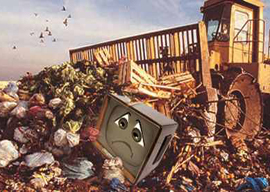
August 02, 2011

It is summer in the city and the smell of trash rises from the hot streets.
There is trash on the sidewalks, trash in the bookstores, and trash in the movie theaters. It is, as it already was at the turn of the last century when Henry James said it, an “age of trash triumphant.” America was then “in the noisiest stage of the noisiest kind of progress.”
“Every daily newspaper is an index of this,” noted The New York Times in 1907. “We furnish our own incriminating evidence in exhibits of eccentric religions, corrupt politics, dishonest commerce, foolish and pretentious society, shallow and immoral literature.”
And what has changed today? We’ve gone from noisy progress to smelly decadence. The New York Times, which was then sometimes used to wrap fresh food, is now mostly used to support spoiled ideas. Henry James’s metaphor has materialized: He was talking of literary trash, and we are literally engulfed in very real heaps of physical refuse.
Cultural trash has always been around, but with only rudimentary means of preserving it—paper reverting to pulp, memory fading over the meaningless—it lived its natural life and quickly died. Physical trash, however, barely existed before the twentieth century. Emerging as an unfortunate byproduct of large-scale industry, it has now become the very fuel that feeds “the economy,” that imaginary monster that we fear, revere, and endlessly placate with bigger and bigger sacrifices, giving it life and watching it shoot out trash.
All the country’s best minds are busy fine-tuning that great invention called trash. A major breakthrough came with the invention of toxic waste, which might well prove to be our most enduring creation, the one through which we finally achieve immortality.
Though there might yet be more virulent forms of effluvium, scientists are still at work increasing trash’s lifespan. In 2009, the FCC ordered the shift to high-definition televisions, by decree making millions of perfectly functional sets obsolete and creating millions of tons of toxic waste for the landfills.
Mostly though, Americans don’t need laws to throw things away. At first they were reluctant, but they have been well-schooled, and it now comes naturally to them.
“Germ-filled handkerchiefs are a menace to society!” warned Kimberly-Clark, who happened to have a product called Kleenex.
“The good citizen does not repair the old; he buys anew,” professed House & Garden editor Richardson Wright in the 1930s.
“Wearing things out does not produce prosperity, but buying things does,” proclaimed Earnest Elmo Calkins, the “Dean of Advertising Men.”
And, straight from the top, Dwight D. Eisenhower:
In these days of unceasing technological advance we must plan out defense expenditures systematically and with care, fully recognizing that obsolescence compels the never ending replacement of older weapons with new ones.
What’s to become of the paper handkerchiefs and metal tanks after their single use? The scientists will come up with a solution, like this SoCal water-treatment plant that so impressed Aldous Huxley in Hyperion to a Satyr:
The chemical revolution begins in a series of huge shallow pools, whose surface is perpetually foamy with the suds of Surf, Tide, Dreft and all the other monosyllables that have come to take the place of soap. For the sanitary engineers, these new detergents are a major problem. Soap turns very easily into something else; but the monosyllables remain intractably themselves, frothing so violently that it has become necessary to spray the surface of the aerobes’ pools with overhead sprinklers. Only in this way can the suds be prevented from rising like the foam on a mug of beer and being blown about the countryside.…Enormous compressors must be kept working night and day.